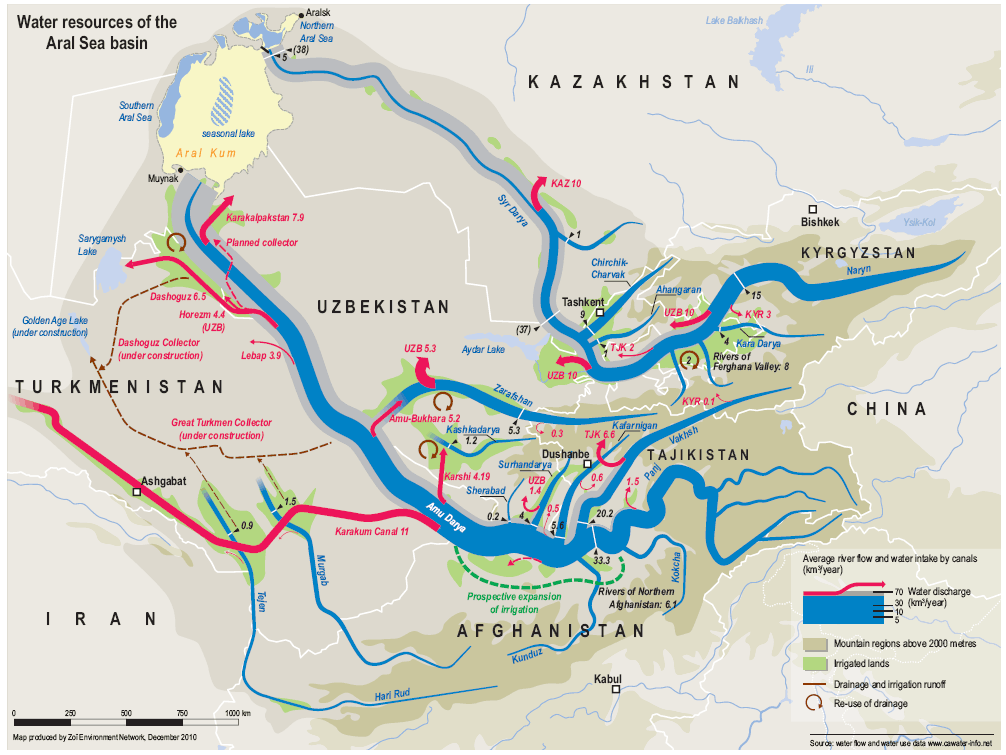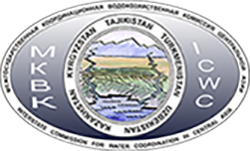Formation and Establishment
The Aral Sea Basin, which covers the whole area of Tajikistan and Uzbekistan, most of Turkmenistan, a part of the Kyrgyz Republic, the south of Kazakhstan, and the north of Afghanistan, is one of the centers where civilizations originated. The two major rivers in the basin – Amu Darya and Syr Darya – have been the sources of life and livelihoods in the region at all times. Today, sustainable development of states in Central Asia (CA) and living conditions of more than 60 millions (as of 01.01.2017) rely on sound and coordinated use of regional water resources.

Before independence, a single water-management system with centralized governance and complex hydraulic infrastructure was formed to meet growing demands of population and economic sectors. More than 80 reservoirs, with the total capacity of more than 60 km3 and the currently operational 44 km3, including 17 km3 in the Amu Darya Basin and 27 km3 in the Syr Darya Basin, were constructed in the region. Besides unique reservoirs and large dams, this water-management system includes the world's largest gravity Karakum canal (currently Garagumdarya), 1 400 km long and with the capacity of 500 m3/s, the unique cascades of pumping canals, including the Karshi cascade, with the capacity of 350 m3/s and the lift of 180 m, and large hydropower stations, such as Toktogul (dam height 215 m and reservoir volume 19.5 km3) and Nurek (dam height 300 m and reservoir volume 10.5 m3).
This powerful system was designed to intensify irrigated agriculture that boosted socio-economic development in the region, on the one hand, and led to disastrous degradation of ecosystems, including disappearance of the Aral Sea, on the other hand.
For efficient inter-republican allocation and use of water in Syr Darya and Amu Darya basins, the USSR Ministry of Land Reclamation and Water Resources (Minvodkhoz) by its orders #300 and #301 of 27.08.1987 established Syr Darya and Amu Darya basin authorities for inter-republican allocation of water and operation of water intakes and hydroschemes (named Uprvodkhoz “Syr Darya” and Uprvodkhoz “Amu Darya”).
Same time, Master Plans for comprehensive use and conservation of water resources in Amu Darya and Syr Darya River Basins were drafted and later on revised. Many research and design institutes from concerned countries were involved in this work that resulted in networking among water professionals in the region.
Thus, by 1991, the region's countries had both favorable heritage in form of cooperation network, available basin organizations, and complex water infrastructure and negative one as inefficient water use and ecosystem degradation.
Formation and Establishment
With the collapse of USSR in 1991 and formation of five independent states in CA, the formerly internal water resources became transboundary ones.
In order to maintain stability in water management, heads of national water agencies from Kazakhstan (N.Kipshakbaev), Kyrgyz Republic (V.Mel'nitchenko), Tajikistan (A.Nurov), Turkmenistan (A.Ilamanov), and Uzbekistan (R.Giniyatullin) met and made a Statement in Tashkent on the 12th of October 1991. The Statement underlined a need for “creation of joint institutions for coordination” since “only consolidation and joint coordination of our actions may contribute to effective solution of regional water problems in light of growing environmental pressures”. It is noteworthy that the Statement starts with the following:
We, the Heads of national water agencies from the Republics of Kazakhstan, Kyrgyzstan, Tajikistan, Uzbekistan, and Turkmenistan, while recognizing inevitable complexities in light of growing water scarcity and environmental stress in the Aral Sea basin and building on historical community of people in Central Asia and Kazakhstan, their equal rights and responsibilities for efficient regional water use, consider it necessary: […]
Thus, thanks to professionalism and foresight, the heads of water agencies put forward and then implemented an important initiative on establishment of a coordinating body to ensure peaceful water management in the context of broken economic and other ties.
As early as in four months, i.e. on the 18th of February 1992, an Agreement was signed between the Republic of Kazakhstan, the Kyrgyz Republic, the Republic of Tajikistan, Turkmenistan and the Republic of Uzbekistan on Co-operation in Joint Management of the Use and Conservation of Water Resources in Interstate Sources that resulted in establishment of the Interstate Commission for Water Coordination (ICWC) - comprised of the heads of national water authorities - for regulation, sound use, and protection of transboundary water resources. The world history has not seen other examples of such a rapid formation of cooperative institutions for shared water.
Initially, only two basin authorities – BWO Amu Darya and BWO Syr Darya – were in the structure of ICWC. Later on, according to ICWC decision of 5 December 1992, the Scientific-Information Center (SIC) for water-related issues was established as part of the SANIIRI Institute and then, in 1996, evolved into an independent executive body. Among other ICWC bodies, the Secretariat was formed in 1993, the Central Asian water sector professional development courses were established at SIC ICWC in 1998, and the Coordination Metrology Center (CMC) was organized in 1999.
The heads of CA states by their decision of 26 March 1993 made in Kzyl-Orda confirmed the establishment of ICWC and its mandate and included it under umbrella of newly created Interstate Council for Aral Sea basin problems (MezhGossovet). After merging of the MezhGossovet and the International Fund for saving the Aral Sea (IFAS) in 1997, the ICWC has become a part of IFAS. During the Ashkhabad meeting in April 1999 the Heads of State signed the Agreement on the status of IFAS and its organizations that gave the ICWC and its executive bodies the status of international organizations.
Support from the side of the Heads of CA State reflects their deep understanding of the key role of joint water management for national development, population welfare and peace and stability in the region.
